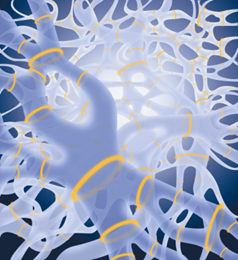String Theory is currently our best candidate for a theory which unifies gravity with the other fundamental forces (the strong nuclear, the weak nuclear and the electromagnetic forces) - it is a proposed "Theory of Everything". String theory was discovered in the 1960's by theorists working to understand the plethora of hadronic and mesonic particles which had been found around that time. The theory had some success, e.g. in explaining the way such particles fitted on to so-called "Regge trajectories", but it was soon replaced, in the 1970's, by a far more powerful theory called Quantum Chromodynamics (QCD). This early string theory had major deficiencies - it contained imaginary mass particles or "tachyons", leading to problems in the quantum theory, the closed strings (loops) contained a massless spin two particle which was not observed, and finally the theory was inconsistent unless the number of spacetime dimensions was 26. The birth of string theory as a possible "Theory of Everything" however, came when it was suggested that string theory was not a theory of hadrons and mesons, but was a fundamental theory, with the massless spin two particle identified as the graviton - the conjectured carrier of the gravitational force.
The "first string revolution" occurred in the early 1980's, when Michael Green (Queen Mary) and John Schwarz (CalTech) discovered supersymmetric strings, or superstrings. Superstrings had no tachyons and had a consistent quantum theory. Furthermore, they predicted a "gauge group" for the fundamental forces. They had natural low energy limits as supergravities, or supersymmetric quantum theories living in ten spacetime dimensions. Soon after, new "heterotic" strings were found, leading to a total of five superstring theories, labelled I, IIA, IIB, HE, HO.

A "second string revolution" occurred around 1995 due to the work of Chris Hull (Queen Mary), Paul Townsend (Cambridge) and Edward Witten (Princeton). "Duality" symmetries between the different string theories were found, which led to the proposal that the five known theories are different realisations of one underlying fundamental theory, called "M theory", whose low-energy limit is eleven-dimensional supergravity. Furthermore, the fundamental objects in string theory and M-theory were found to include higher dimensional surfaces called "branes" as well as strings. The study of these has led to major progress in many areas in the past ten years. One key development was that of gauge theory/gravity holographic dualities in M-Theory, which began with the Matrix Model of Banks, Fischler, Shenker, Susskind and the AdS/CFT correspondence found by Juan Maldacena.
The twistor revolution. A new duality between gauge theory and string theory in Penrose's twistor space was found by Edward Witten in December 2003. The discovery of a twistor string description of the hitherto mysterious simplicity of scattering amplitudes in gauge theory prompted rapid new developments that have delivered unexpected conceptual insights into the structure of gauge theories, gravity, and string theory. This has led to completely new, powerful computational methods for amplitudes and interesting new applications in mathematics. More recently, the discovery of the amplitude/Wilson loop duality has had many ramifications, and has revealed fascinating hidden structures in gauge theory which inspired novel formulations of field theories based on momentum twistors and Grassmannians. It is expected that these developments will lead to far-reaching reformulations of quantum field theories and many practical applications relevant for QCD amplitude calculations and phenomenology at the Large Hadron Collider (LHC) at CERN in Geneva. Members of the Queen Mary group have been at the forefront of this research area since its inception in 2004, contributing in 2007 to the discovery that the duality between amplitudes and Wilson loops found at strong coupling by Fernando Alday and Juan Maldacena, of the Institute for Advanced Study in Princeton, also applied at weak coupling.
Other areas of active research in current string theory include the study of time-dependent and cosmologically relevant aspects of brane dynamics, integrable structures in gauge theory and new geometries in string theory. Queen Mary researchers play leading roles and are involved actively in many of these new areas of research.
Popular publications by members of CRST
- David Berman has written an invited article on string theory for the December 2007 issue of Plus+ magazine, aimed at school audiences - String theory: from Newton to Einstein and beyond.
- Andreas Brandhuber, Bill Spence and Gabriele Travaglini have written an invited overview article for Contemporary Physics, aimed at non-experts: Twistor-inspired methods for gauge theory and gravity, on the recent striking advances triggered by string theory ideas on our understanding of the structure of the scattering amplitudes of elementary particles.
